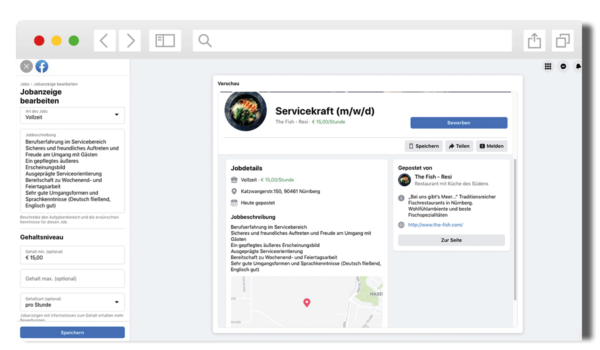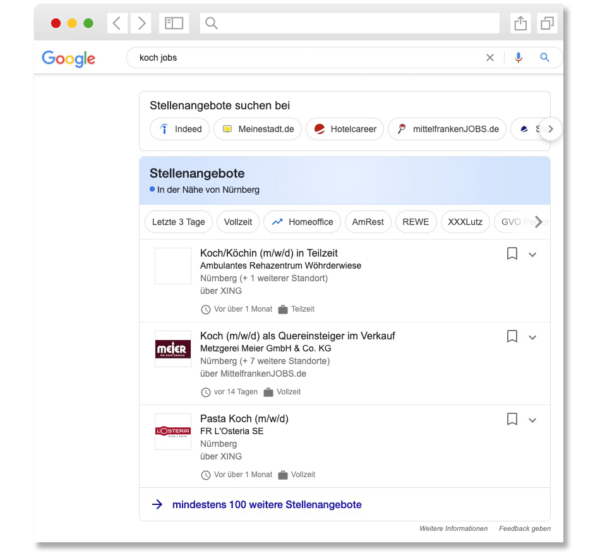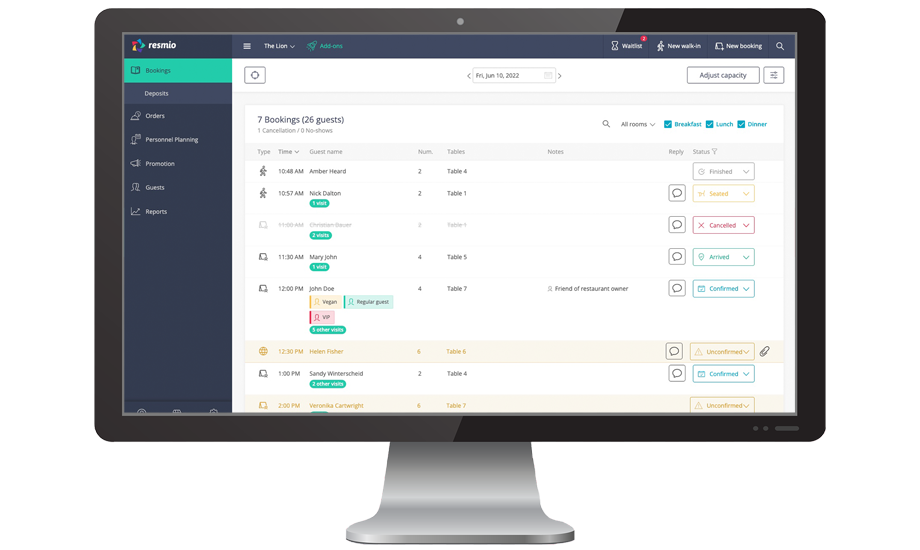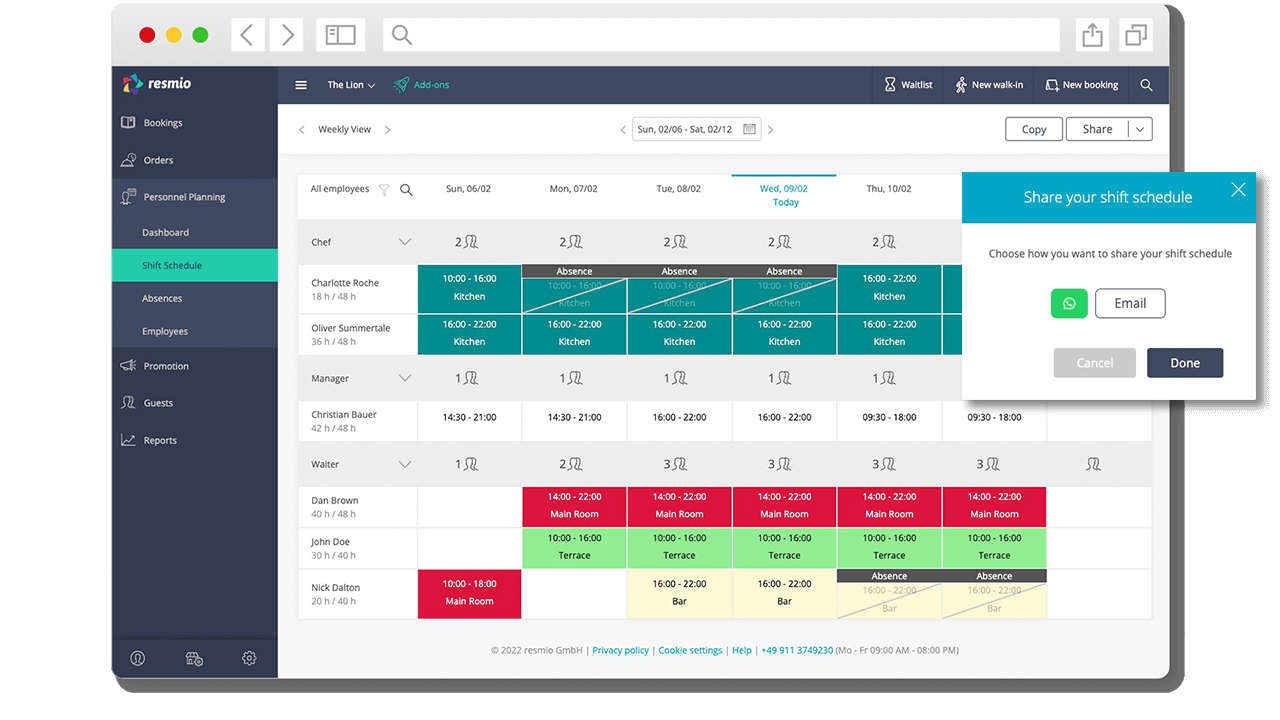Tough shutdowns and access restrictions during COVID 19 have not only led to a loss of guests in restaurants. An already well-known problem from the past is also coming to light more than ever – staff shortages. So what to do about the tightening staffing situation? We’ll show you how you can successfully compete for qualified professionals and at the same time support your existing staff with digital tools.
Table of contents
Where have the professionals gone?
The shutdown of most restaurant businesses in the first half of 2021 has forced staff in the hospitality industry to seek new career opportunities. Even temporary workers such as students, on whom many restaurant operators relied primarily for monetary reasons, have become noticeably scarcer at the latest with the end of the second, large wave of the pandemic.
The consequences of the COVID 19 crisis on the labour market: a drastic shortage of staff the likes of which the restaurant industry has never experienced before.
According to the German Federal Statistical Office, the number of employees in the catering industry fell by 23.4 per cent – and thus by almost a quarter compared to the pre-crisis year 2019. Bars have been hit even harder, with almost every second employee affected here (44.7 per cent).
Source: German Federal Statistical Office, January 14, 2022
The loss of highly qualified staff is particularly severe. Experienced chefs and waiters with several years of professional experience have taken the crisis as an opportunity to make a lateral move into other industries. The result today is that the labour market for qualified restaurant staff is practically exhausted. Filling vacancies with trainees is also a problem. This is because the apprenticeships are considered unattractive. Even before COVID 19, every second traineeship for restaurant specialists and chefs was terminated prematurely (content piece in german).
For most restaurateurs, this threatens their existence. After all, well-trained staff in the kitchen and service ultimately make the difference, especially in conurbations with numerous competitors.
So far, we can state the following:
The increased fluctuation of staff will continue to affect restaurant owners even after the COVID 19 pandemic is over.
Reasons for staff shortages in the restaurant industry
Yet the situation does not come as a surprise. It was already on the horizon before the pandemic began. In this case, the crisis and its effects on the hospitality industry acted as an accelerant.
The reasons for the shortage of staff in the restaurant industry can be summarised as follows:
- Low wages with monthly average salaries (gross) for restaurant workers of 2,200 euros and chefs 2150 euros (data refer to Germany). Without work experience, the salary is significantly lower again.
- Tending towards inflexible working hours (including regular shifts at weekends), contrary to the increased demand for work-life balance
- A work environment without great career opportunities or training options
- An anticipatory reputation of a harsh working environment that leaves little room for self-development and appreciation
- A demographic-driven shift away from an employer’s market to an employee’s market. Not staff applying for companies, but entrepreneurs recruiting staff
- A recruitment problem in the hospitality industry is the result of a greater proportion of students. Fewer young people aspire to training in “classic” handicraft and service professions
How can the shortage of staff in the catering industry be addressed?
In the short and medium term, however, the above-mentioned measures will probably not be able to alleviate the staff shortage.
Seems like the end of the world. Well, yes and no.
To tackle staff shortages, we need more than ever a will to change. Sounds like a platitude at first, but without the push of long-postponed innovation processes, the hospitality industry can no longer do it!
The goal is to make the restaurant industry attractive to applicants. And that starts in your own business.
You have to position your restaurant as an appealing workplace, address the above-mentioned shortcomings and offer (non-monetary) incentives in exchange for labour. In order to absorb the higher costs of competitive wages and employee benefits, a solid price calculation is indispensable.
And yes, in the end guests will have to pay more for gastronomic services. This also applies to your competitors, who are most likely in a similarly precarious situation.
Because there’s no other way.
Because salary is not everything – appreciating employees
It is not only since yesterday that one can read in smart guidebooks how important the topic of appreciating employees is for retaining them. A fair salary is one point, of course. But for more and more people, the meaningfulness of their work is also becoming a decisive co-criterion for or against a company.
Honouring the performance of your staff must now be one of your top goals.
But what does this mean in concrete terms for implementation in your own restaurant? Where do I start?
- Asking about the well-being of each employee in a proactive way is a first step. How are you doing, how is work? Are there any obstacles, or problems on your part?
- Five to ten minutes of time per conversation per week can do the trick and strengthen staff loyalty.
Important thereby: do not pretend to be personally interested under any circumstances. Instead, listen carefully to understand staff needs. - (Semi-) annual feedback meetings to discuss employees’ (personal) perspectives and development are standard practice in modern companies.
- Involve employees in company decisions: For example, you are planning to buy an ePOS system or a digital reservation system? Involve the staff in the decision-making process. In the end, everyone benefits from the expertise. In this way, you can also promote potential that is sometimes hidden and give employees new responsibilities if they are interested.
- Create a praise culture in the company that rewards commitment and effort. Good praise is characterised by the fact that it is honest, well timed and personal. Let your employees know that you value them by giving them feedback on the quality of their work.
- Regular team events such as a monthly staff breakfast or leisure activities outside the restaurant open up spaces to get to know each other from a different perspective.
Create regulations for flexible working hours in the restaurant
Business needs and extended working hours in the hospitality industry increasingly collide with the wishes of professional staff for flexible working hours and a work-life balance.
The following measures can help to align your interests with those of your employees:
- Starting to draw up duty schedules at an early stage gives you and your employees more planning security. At the same time, there is room to react to individual special requests. This usually leads to a decrease in spontaneous shift requests, because private appointments have already been taken into account in advance for staff scheduling.
- Allow flexible exchange of shifts within the team – this gives staff a certain amount of autonomy and thus organisational responsibility.
- Stagger the daily start and end of work for your employees: The first service worker on the early shift could start work at 9 a.m., for example, the colleague at 10 a.m. and so on. This allows your employees to sleep in and go home earlier.
- By introducing annual working time accounts, employees can work longer and shorter hours depending on workload and demand.
Attract new employees: Impress with your job posting
Recruiting in the hospitality industry can be particularly challenging given the reasons outlined earlier in this article. In order to maximise the chances, we outline below recruitment processes that you should put to the test in your restaurant business.
- Your job title has to be right: Clearly state which position is vacant. Refrain from choosing abstract job titles such as “kitchen magician” or “plate artist”. Although this may be creative and eye-catching, the position may be misunderstood or perceived as unserious. Also, job titles such as ” bar wizard” are undoubtedly not a common search term on job boards, which is why such ads are less likely to be found by prospective candidates.
- Start by saying a few words about your restaurant and your team so that the potential applicant can get an idea of your restaurant, the atmosphere and the clientele. The rule here is: always remain authentic!
- Be sure to mention important key data such as: Entry date, location(s), type of employment (full-time, part-time, temporary).
- Describe the tasks that await the applicant. Define an individual job profile that fits the respective position, including the required qualifications, necessary professional experience and desired, but not mandatory skills. Make sure you don’t look for the “egg-laying jack-of-all-trades”, otherwise you will scare off potential applicants, career changers or candidates who are just looking for a part-time job.
- After you have presented your requirements, it is time to point out the benefits of working in your company. Only give truthful, realistic information. In the long run, no one will benefit if you promise flexible working hours, for example, but are unable to keep them in the end. New employees quickly find out about empty promises, which can lead to a lasting breakdown in the relationship of trust. This way you would only damage staff loyalty. So come up with something to convince applicants of your advertisement.
Possible incentives are:- Bonus, variable salary, Christmas bonus
- Further training e.g. barista, hygiene training, bartender basic training
- Discounted or free food and drinks (also outside working hours)
- Team events
- Make the application process as simple as possible by specifying how to apply (email, applicant portal, contact by phone), which documents are desired and who the contact person is. Incidentally, some job portals offer the quick application option – upload your CV via smartphone while on the move and you’re done!
- Not only the amount of information is important for a successful job ad, but also the design of the post and the composition of the ad round off the overall impression. For example, you can use images, icons or pictograms to illustrate benefits. A suitable mood picture of the working environment and the friendly team can already be an eye-catcher. And never forget – especially online – to use a call-to-action like “Apply now”.
How do I reach as many potential applicants as possible?
Many restaurateurs hang job ads on their front door. But if you are really suffering from a lack of staff, you have to publish jobs online and offline and spread the openings as widely as possible through as many channels as possible. The following options come into question for this:
- Job boards, such as Indeed, Stepstone, the employment agency or, especially for the catering industry, gastrojobs.de.
- Social media: Facebook, including your own FB company page, Facebook groups or Facebook Jobs and Instagram. Linkedin and Xing are good for reaching career changers.


- Via Google: Share job ads via Google for Jobs, share jobs for free via Google My Business’ post feature, or consider Google Ads for a budget of your choosing.
- Own website with careers subpage
- Regional advertising papers and newspapers
- Your own promotional flyers with a notice of vacancies that you could include with food orders
- Place a display at the table or put the job application on your menu
- The classic bulletin board at universities and colleges is a good way to find (seasonal) temporary staff.
- Paid multi-channel posting (e.g. zoove, compana): a well-known tool from the HR industry to generate a lot of reach across as many websites as possible. With just a few clicks, job ads are automatically posted on various job portals, job boards and platforms at the same time
- Recruitment consultants and temporary employment agencies: Even if they do not enjoy the best reputation and a commission is due in the case of a placement, it can make sense for some restaurateurs to also search for suitable skilled workers through this channel.
Employer branding: polishing up the corporate brand
Besides excellent labour conditions and an attractive salary, it is also important to promote yourself as an attractive employer. The term employer branding may not come up so often in the context of the hospitality industry, but it is still vital in order to attract young talent and new staff. This is how you can proceed:
- Check what image you currently project as an employer. Scan your website, online reviews, social media channels and ask (former) employees about their impression.
- As an applicant, can they tell what makes you and your team tick?
- What benefits do you have to offer as an employer?
- What sets you apart from other restaurants?
- What is onboarding like in your restaurant?
- How do you deal with employees when things don’t run smoothly?
- The current situation is known. Now it’s time to implement suggestions for improvement from employees. Try to eliminate a negative web presence and revise outdated content on social media and websites as well as advertisements.
- Live the values preached in the workplace, keep promises and listen carefully to your staff. This will ensure employee satisfaction. Only then will you be able to build an authentic employer brand, present it online on your channels and maintain this image in the long term.
Reducing the workload on staff: Addressing staff shortages with digitalisation

Digitalisation is an important piece of the puzzle to overcome staff shortages. Digital solutions such as online reservation systems and AI-supported telephone assistants, for example, reduce the daily effort involved in answering reservation requests from guests. Self-ordering concepts with a digital menu that can be called up via QR codes largely decouple the acceptance of orders from staff – existing employees are significantly relieved.
A wide range of these tools are combined in one system by resmio. They help you to find new staff or to cope with fewer employees for a limited period of time.
Online reservation system
A clear benefit of an online reservation system is that it reduces the workload of your staff. Unlike e-mail and phone, online reservations are accepted automatically via the internet. Your employees do not have to manually enter new table bookings via your website and Google – especially on weekends with a high throughput, this is worth its weight in gold!
If guests do call or spontaneously come to the restaurant, your team will immediately receive suitable table suggestions for the size of the group and can make the best possible use of available seats in the restaurant.
Table ordering via QR code
Less walking, faster service and more time for other tasks: This is made possible by the self-ordering feature via a QR code.
With this concept, guests simply order and pay themselves. A digital menu is called up on the smartphone they bring with them and then the desired food and drinks are placed in the virtual shopping basket. The advantage for the staff: administrative tasks such as taking orders and cashing up are largely eliminated.
Several studies confirm that table orders via QR also have a revenue-boosting effect. The fact that guests can order regardless of the presence of your staff increases additional purchases.

Digital staff plan
Work-life balance is an important factor for almost every employee these days when it comes to staff satisfaction. The hospitality industry often faces challenges in this regard. Shift work in particular makes it difficult to meet all demands. Nevertheless, binding working hours, a reliable duty roster and fair shift assignments can contribute to this.
The digital shift plan from resmio creates the necessary transparency and supports restaurateurs in optimising the staff schedule.
Google Ads for recruitment
Ever thought of placing ads for job vacancies? Google Ads is a promising tool for recruitment. You don’t even have to do anything yourself to attract potential applicants to your restaurant. We’ll be happy to take care of everything from placing the ad to measuring the success of your campaign. You can set the monthly advertising budget yourself. A modern homepage significantly increases the chances of success.
Your own restaurant website
The website is often the first point of contact with your restaurant for potential applicants. Through the design and especially the content, you are able to give potential applicants a first, authentic insight into the working environment, corporate culture and staff management (which is what a modern restaurant website is all about).
Unlike job portals, you don’t have to adhere to a fixed structure when posting jobs on your company’s website. And it’s more affordable, too, because you don’t have to pay any agency fees. This makes the website especially valuable for smaller companies with a manageable budget for finding employees.

Summary – Facing the staff shortage head-on through own change
The staffing situation in the hospitality industry is difficult, not only since COVID 19. To make the restaurant industry attractive again, working conditions must improve significantly. A fair salary is only one factor. In the fight for the best skilled employees, restaurant operators must also rely on non-monetary incentives. Flexible working hours and team-building measures are examples here.
The overall overhaul of your recruitment process should also be under scrutiny: Starting with employer branding and the structure of your job ads to the choice of communication channels.
In the short term, it is advisable to streamline operational processes with digital tools and thus noticeably relieve existing staff in day-to-day business. resmio offers appropriate solutions for this. We would be happy to advise you in person.
The satisfaction of the remaining staff and a pleasant return to work should also be a high priority. Not only because the competition might poach them, but also because they contribute to the external image of your employer brand. This is the only way you can defy the staff shortage in the catering industry in the medium to long term and attract new employees.

